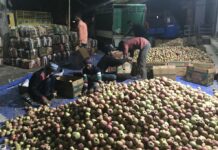They had to wait 28 years for a small lift irrigation scheme to complete, meanwhile people living in the 18 Tral villages suffered losses in agriculture. Syed Asma reports
The villagers around Rajpora thought that their irrigation woes were short-lived when Shiekh Abdullah laid the foundation stone of a lift irrigation scheme in 1981 in the area. But it was only three decades later that his grandson, Omar Abdullah would inaugurate the partially completed project.
The Rajpora lift irrigation scheme envisaged lifting water from river Jhelum where from two canals -Rajpora and Midura – would carry the waters for around 7500 metres and 6500 meters respectively on the way irrigating around 18 villages.
The construction work on the project was stopped from 1989 to 1997, which authorities say was done due to turbulence in Kashmir.
However, the works were taken up again after the project received funding under central government’s Accelerated Irrigation Benefit Programme (AIBP) in 2004. AIBP was launched during 1996- 1997 to give loan assistance to the states to help them complete incomplete major/medium irrigation projects which were at an advanced stage of completion, to create additional irrigation potential in the country.
Though, Midura canal is complete, only one third of the Rajpora canal is complete.
Putting the blame for non-completion of the canal on people, Rouf Jan Mir, junior engineer of the project says, “People are themselves delaying the project, who despite suitable payments are creating problems in handing over their land for construction purpose.”
However, even the incomplete project is catering to a vast area of Tral. “In comparison to last year our fields, trees, vegetables, fruits seem to have gained new life as the irrigation canal started,” said Ghulam Hassan, a resident of Nanar, Tral.
In past few years the agriculture in the area suffered badly as Midura natural stream became seasonal and dried up in lean seasons especially since 1999.
Many people claim that they were forced to shift from paddy cultivation to maize and other crops needing less water.
“We would get enough paddy from our land to feed our family but due to scarcity of water we had to plant almond trees in the land, which do not serve the purpose (of feeding the family?),” says Ghulam Hassan, resident of Chek, Tral.
Many others have also stopped cultivating paddy in the area where rice is the staple food.
“I had 20 kanals of paddy fields and vegetable fields but due to lack of irrigation I had to convert them into orchards,” said Abdul Ahad of Chek, Tral. Residents of Chek claim that about 10 hectares of paddy fields in the village were converted into orchards. “It is not just paddy, we were unable to cultivate mustard and vegetables, making us poorer,” says Abdul Ahad.
Apple and almonds trees do not pay off immediately as it takes these four to seven years to bear marketable fruit. “From last 5-7 years we are just taking care of these tree…spraying pesticides etc. But have not yet got fruits from it. In a way we have only invested in them but got nothing in return,” says Ishfaq Ahmed who apparently is unhappy with converting paddy fields into orchards. But his father hopes that orchards too will help to earn handsome amount.
To compensate the loss, landowners cultivate pulses and cereals till the orchards are ready to bear fruits.
The farmers are optimistic that the irrigation scheme will benefit them directly and help them in returning to paddy and vegetable cultivation.
The main source of water in this irrigation project is river Jhelum. Water is lifted in two stages. Stage I is at Larkipora from where four pumps are used to lift water directly from the river. Then stage II is at Bahu and the water canal gets separated into two different canals Rajpora and Midura. The project has the potential to benefit 2429 hectares which includes 1620 hectares of Khareif and 809 hectares of Rabi crop. The cost of the whole project is 62.98 crore.















